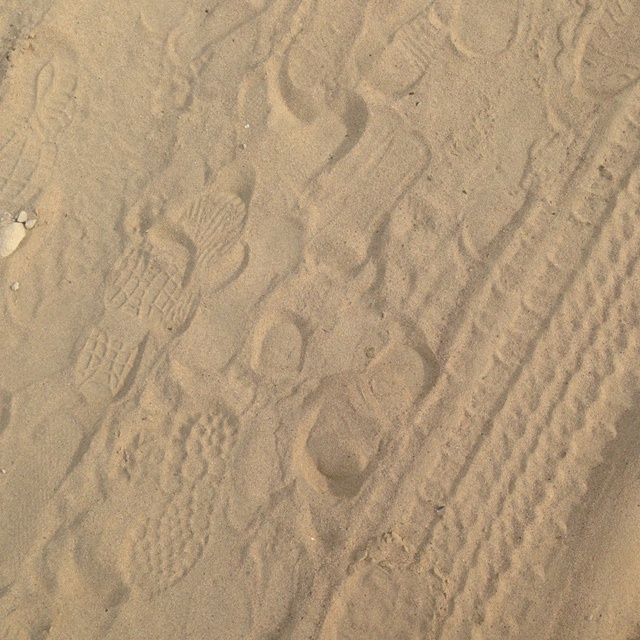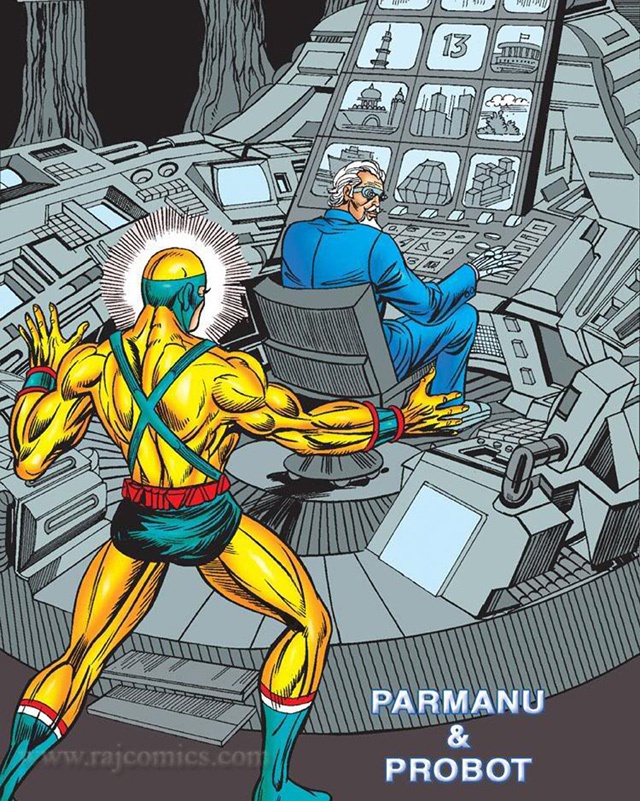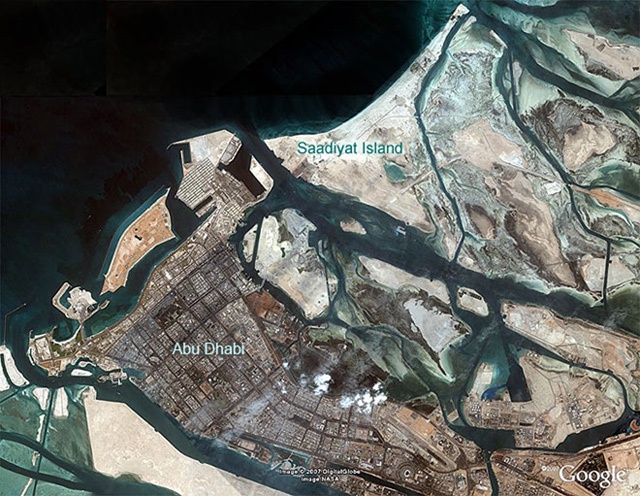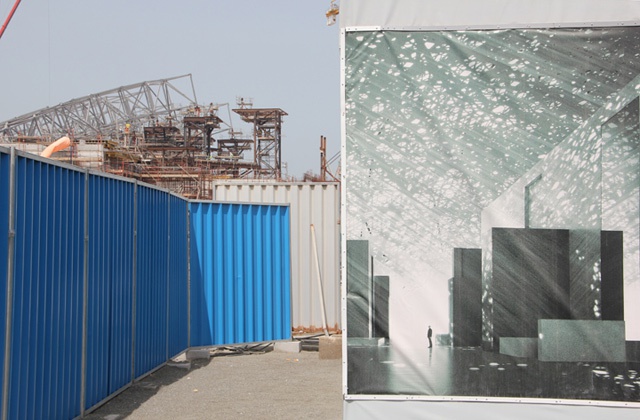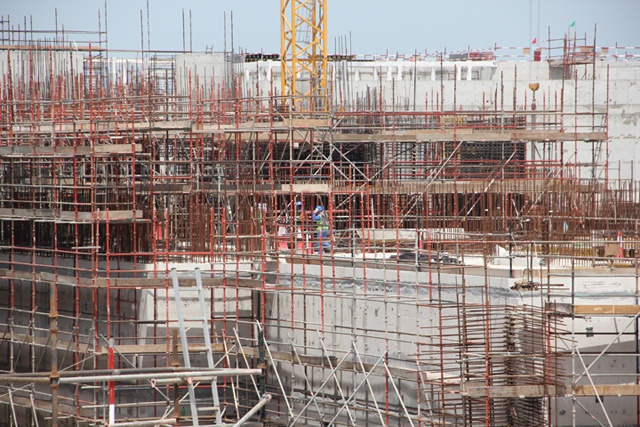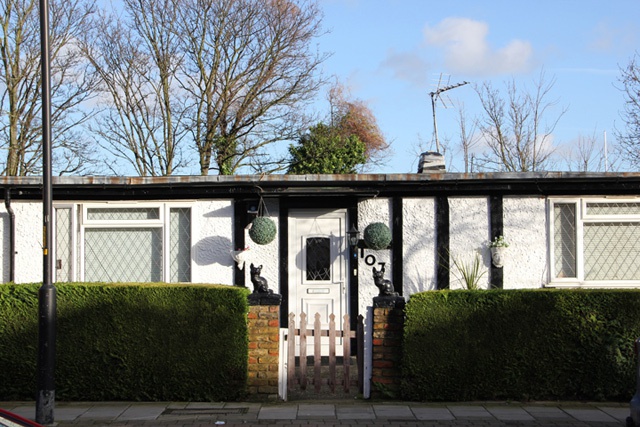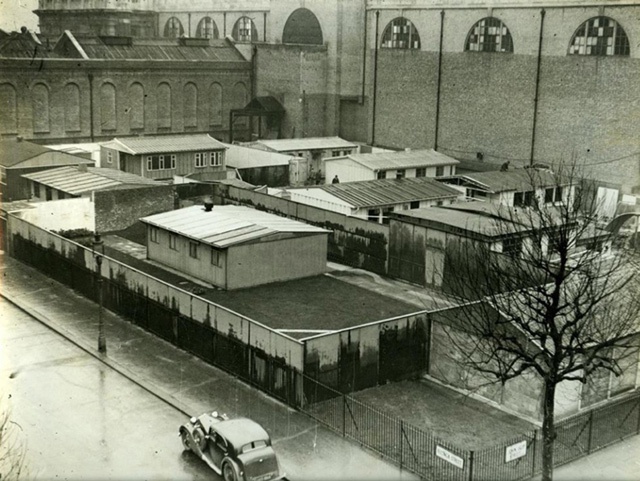Essays
Utopian Dust Versus Perfumed Amplification
Object Lessons from Saadiyat Island and Gehry’s Guggenheim, Abu Dhabi
An Introduction to the Present
The good news about the future is that there is not only one but many, and none will abide by expectation. The Gulf will not taste of Charles Fourier's utopian lemonade, even if the Arctic melts, nor will it smell like Serpentine, the pride of London's art-world.
It's necessary to state this simply because we exist at a time when a more singular notion of 'the future' is being furiously hedged against. Hedged most ubiquitously within the realms that institutions relating to visual production are presently conceived: cultural policy, urbanism, architecture, development or construction. In recent decades these have become a single entity in the service of global capital.
Since the early industrialized powers declared war, as Michel Serres so definitively put it, on the ecology of our common world, a lexicon that includes 'future-proofing' and 'sustainability' does have referents.[1] However, it's not concretized in climate change but in balance sheets, capital fluidity and returns. In this context, future-proofing is all about now: guarantees of profit streams and access to them today. It's a lexicon evacuated of substantive sense and can't address how to survive such a war.
To escape from abjection, especially when constrained by ecological correctives to our existence, we must re-conceive the formation of our futures. Futures catalysed, for example, by reference to a conventionally dismissed Utopianism, like that of Charles Fourier's: 'a perfect anachrony to capital's pre-emption of the future through calculated responses in the present.'[2] We know how we got here; it's time to chance everything on our escape from apparent captivation with, or captivity by, crass mechanisms of capital, contract and commodity. Mechanisms which have guaranteed that the kinds of institution I refer to have been reduced to a single possibility: the spectacular shop, within an infrastructural context derived from eighteenth century Europe.
The best and perhaps most unfortunate single example of this phenomenon is the Frank Gehry-designed brand-extension of the Guggenheim that will sit alongside other cultural institutions on Saadiyat Island, just off the coast of Abu Dhabi. It's an obvious but complex example which I'm using to conceive better futures than one redeemed in this kind of predictable past error. Conditions of acceleration in the Gulf allow us to run broken-down and stitched-together Utopian ideas through this concrete example.[3] I insist on being understood as a critical friend with deep interest and some intimacy with the Gulf and broader Indian Ocean world. Crude negativities are abundant. I'll hold onto my curiosity about – and appetite for – the expansive actualities I experienced afresh this March, even while also visiting labour camps throughout the Emirates.
...
I am making tracks.
I walk through mounting sand and ahead of me is a remote, rather ramshackle camp for full-time taxi drivers. Beyond that, another camp is home to cleaning staff for five-star hotels on the horizon. In the mid-distance industrial-scale labour camps house thousands of south Asian men entrapped by debt, their lives at the service of vast quantities of concrete, steel and art institutions.
I lay down my footprint with a crowd of anonymous others and before me is a stained-walled compound where the pavement-washers dwell. The ones that drive up and down in continuous loops on the momentarily dust-free pavements around the base of a towering fancy as I pass on foot with an émigré artist in the early hours one March morning. We share one certainty: the storm will come again.
I watch my feet kick through sandy trails, reshaping other footprints in chaotic densities along improvised tracks. They lead through dune-like hillocks of disturbed ground towards a fierce six-lane highway. I follow the logic of feet that have come before me in a dash to the middle section, stand beside owners of similar footprints, and provoke them into a final sprint before they're ready. We resume in a kilometre stroll over rain-hardened ground, inhabiting the Hindu Kush with words as we follow millions of preceding footprints into unpaved alleyways between labour camps serving this and neighbouring Emirates.
I enter as a particle – even a particulate – amongst others, attentive to a certain invisibility that relates directly to the spectacularity of institutions feeding on people and places like this. Camps detaining the men who build the towers and corniches, drive the trucks and dig the trenches, die from tall buildings or debt burdens. The feet of men who build the 'palaces for the people' – as Saadiyat's cultural institutions were termed in 2007[4] – under 'conditions of forced labour.'[5] Palaces designed to be inaccessible to their feet and dust-proofed with the future-past. Cultural institutions borne of a trackless and unsustainable amplification.
...
Only a decade ago, 2014 formed the future horizon of a remarkably ambitious plan to develop Saadiyat Island as a culturally-driven city quarter of global stature. The impetus was to plan for a post-oil economy, and develop ways or places to draw a global audience to the region and a service-based economy to go with that. Thomas More conceived his Republic of Utopia as an island in 1516 but with Saadiyat there were the resources for plans on this scale to actually take place. A decade on, the plans have shifted to redefine the future claimed. Today, many elements of what the Guggenheim's Thomas Krens described as 'the greatest concentration of contemporary cultural resources in the world'[6] are yet to be realized – and so remain negotiable.
Krens, the Guggenheim Foundation's Director who oversaw the Abu Dhabi deal (but was replaced by Richard Armstrong in November 2008) and claimed credit for conceiving the Cultural District's cluster of Pritzker-Prize-Winner-designed institutions, wanted his spectacular shop to be one of the 'top elite cultural institutions in the world.'[7] Those would include Rafael Vinoly's New York University campus, Jean Nouvel's Louvre Abu Dhabi and one day even Zaha Hadid's 'cherry' of a performing arts centre[8]. Explicitly, 'the Gehry museum was designed to be out of proportion and out of scale with what existed.'[9] The banalities of this kind of amplification are too easily savaged for me to do it here.
Instead, it's worth examining what generates such error, which for all its monstrousness is also branding every part of the world where urban development is taking place: from Abu Dhabi, through London, Sydney, Oslo, Gujarat, and so on. This model, founded by the once revolutionary Louvre, has matured to the point at which these same institutions increasingly resemble London's Bond Street boutiques, complete with own-brand perfumes[10]. It is a model barely changed in 200 years[11] which, if not entirely redundant, is now merely continuous with the decontextualizing spaces of globalization.
I remember my disorientation after first exiting a museum exhibition through a gift shop. Before then, I enjoyed hub airports for their decontextualizing qualities, even if best exemplified by nights at Saddam International Airport, during a hijacking and the Iran-Iraq War. The Museum has, as per cliché, become the shop as part of a totalizing process in which everything is, or aims to be, decontextualized in this way. It's most pernicious and predictable when the global institution is being built from scratch. As such, it's necessary to articulate some principles and arguments upon which a different approach can be founded and built.
We're on the cusp of different kinds of futures: the taking-up of so-far unclaimed spaces of globalized capital for social, political, ecological needs, desires and benefits for a newly migrant subject or citizen in a world that is scrambled, multi-polar and perilously warming. While these radical conceptual changes are barely emergent, they require new imaginings and articulations, to put it crudely, which ought to be obvious to all. That is, let the globalised spectacle redeem itself in the past, our futures will require new networks of unconstrained dreams, commonalities and autonomous actors.
It's all a matter of dust. One that includes sand, small even invisible objects – human and non-human – in various symbolic, cultural and all-too concrete measures. A figure or figures that the spectacular shop-approach to future institutions ignores, can't see or comprehend, refuses responsibility for or insures itself against to maximize rewards in the Now. All future institutions will be judged by their relation to dust of these kinds.
...
What scale ought we consider or conceive the multitudinous dust to be? Viewed climactically, we are very many, and very small with very simple, common imperatives for life. We obtain no priority, or much notice and are raised to a gracious equality with all else that exists. As humans we share physical conditions of existence, while our differences are almost imperceptible. However, I'm interested in scales of this order as they relate to the urban, to institutions, buildings – including dwellings. Bear with me.
Parmanu is an Indian comic strip named after its hero: 'Atom'. In this wonderful image Parmanu stands over an accomplice called Probot: a 'starchitect' working on a series of gestural buildings that can only be a reference to Gehry and his spectacular shops. Probot is intently digging up some local context or reference to stick together with that angular or 'inspiring!' shape on the bottom screen as a proposal for the next Guggenheim perhaps.
Actually Parmanu and Probot are protectors of Delhi and the screens represent a CCTV-like security system in the city. I'm more interested in scales of dust or sand or ideas smaller than Parmanu the atom; that realm of the unseen, 'invisible', intuited, overlooked, not-translated or Klugean 'blind spot.'[12] Add another easily overlooked 'a' to his name and you arrive at my point of interest: the paramanu, a term from India's Vastu Shastras which is used as a principle and measure for building and nowadays is said to refer to sub-atomic particles. Traditionally, these measurements begin with a unit perceptible only to the sage or visionary figure who has 'mastered their senses.'[13]
The paramanu is smaller than a particle of dust thrown up by the wheels of carriages. In fact, there are eight of these particles to every dust speck. Thereafter, there is a very tightly specified and gradual amplification of measures which expand from the 'formless': atom, dust particle, the tip of a hair, a nit and on to recognizable scales like a grain of barley, a forearm and danda or staff. Every aspect of building was governed by these measures, which further determine all relations of form in linked proportions. Amplification begins at a level too small for the incurious eye to see and expands with visceral affect.
How different this is in approach to the cartoonishly assertive fancies dropped in cities, on sea fronts or islands to be surrounded by cultural infrastructure, vast amounts of retail and countless cafes – like little squirts of perfume?
...
In 2004 at the same time that 7,000-year-old dwellings were unearthed on Marawah island in the Gulf[14] the future descended on Abu Dhabi. Saadiyat, the Island of Happiness or Contentment, was an undeveloped island with few archaeological traces, just across an inlet of Gulf water from the capital city of the United Arab Emirates. There were resources at hand and what resources they were! Only a wish list was required to absorb the riches of a tiny nation with vast oil and natural gas reserves and a matching sovereign wealth fund. An initial masterplan was prepared by Gensler Associates, a global corporation from the USA, for a 27 square kilometre city quarter. It would be half the size of Bermuda and accommodate a population equal to the city of Oxford.[15] The plan included sectors dedicated to leisure, hotels, retail as well as the Cultural District which would be a driver for all the rest.
Ambitious Emiratis were in a position to persuade those they regarded as the best examples of universal, national, and contemporary institutions across the world to become lavishly rewarded 'partners' in their Utopia. They took a steely-eyed view of old-western institutions in relative decline and seduced them into trading sufficient expertise in museology to ground their own future institutions. At the same time there would be loans from museum collections: classical, modern and 'contemporary'; and substantial funds allocated to acquire new collections to bolster those and leave Abu Dhabi in a position to take full ownership of the institutions and new collections 30 years into the future.
The histories of Emirati dwelling and trading sites are increasingly well researched, with excavations revealing links with the Indus Valley Civilisation over thousands of years. Archival interest in more recent decades of cyclical development is growing, not least in the UAE's capital city. UNESCO are likely to confer World Heritage status on Dubai's deserving creek area in 2014 too. Meanwhile, downtown Sharjah is engaged in a process of reinvention that involves large-scale demolition and betrays a curious distaste for its post-independence aspirations. Alongside it the Sharjah Art Foundation has been building cultural institutions with lessons for the future which I will return to. While ignorance about these histories is common, the island that became Saadiyat had only a few late-Islamic era remains in 2004 and so offered a near tabula rasa. This very rare condition goes some way to ameliorate cruder criticisms of the totalizing 'something' being built in place of 'nothing'.
Let me come back to that by way of origins. Abu Dhabi wanted a 'Universal' museum in the epistemologically 'Western' mode: a unipolar panorama of global cultures gathered in a single location, a first for the Emirates. Their discussions and agreement with the Louvre to bring the model museum and 300 objects from its 'world-class' collection to Abu Dhabi, were a founding factor in the broader plans for Saadiyat. Greek and Roman spoils which filled the revolutionary Louvre would now transfer some of their pedigree to Abu Dhabi. All of this was critical in persuading Thomas Krens to bring his brand on board, as he would put it. Otherwise, discussions with Abu Dhabi, he bragged, had not been 'automatically like, "Wow."'[16]
Brand is key here: the Louvre's rewards include $715 million for loans and expertise and $525 million or an annual payment of $17.5 million every year of the 30 year-long agreement, for the use of the Louvre's brand alone[17]. There was also $32.5 million to refurbish a wing of the Pavilion de Flore[18] and other sweeteners plus the usual billions in armaments and aircraft which are, naturally, unrelated. We have to assume a comparable level of reward for brand Guggenheim too, although it lacks the confidence to divulge the information.
Hito Steyerl's brilliant video Is the Museum a Battlefield (2013) traces circuits between elite art institutions, military hardware, potential war crimes, complicit starchitects and others, as well as the financial sponsorship that links them all in the new regime of global biennials. She states gleefully that 'one could say that the Louvre was created by being stormed',[19] and maintained as a public art museum through repeated storming between 1793 and 1871. Anecdote possesses the force of 'street insurgence', as Walter Benjamin wrote in The Arcades Project,[20] versus the orderly ranks of historical narrative. What is beyond substantial dispute is that 'the appropriation of a certain space, which had to be opened and broken into, was the first delight of the Revolution.'[21]
This model of the state museum represented by the Louvre was created in accelerated conditions for the first anniversary of the revolution on 10 August 1793 and was a significant part of the grounding and narrating of the new Republic. So significant a part that there were wry questions asked at the time about whether, if older plans for a 'public' Louvre had been delivered, it might have 'saved the monarchy'[22] from the guillotine and tough-minded Republicanism. As such it seems a striking choice for Abu Dhabi and the United Arab Emirates to make during a phase of unprecedented internal change in a world undergoing significant realignments.
The UAE is a federation of hereditary monarchies, governed by a Federal Supreme Council (FSC) representing the seven emirates. The FSC elects the President and Vice President, posts which have so far gone to ruling Sheikhs of Abu Dhabi and Dubai respectively. In 2006, the Federal National Council was inaugurated and made up of appointees and elected figures to perform a consultative role: 'examining and, if it wishes, amending all proposed Federal legislation'.[23] The Tourism, Development and Investment Company (TDIC) is a public company owned entirely by the government of Abu Dhabi. They describe their choice as follows: 'Louvre Abu Dhabi is being developed with the expertise of the Agence France-Museums and in partnership with the Musee du Louvre, renowned for its museological excellence since its foundation in 1793.'[24]
So much for the symbolism of a revolutionary anniversary! The substance is arguably more relevant as the revolutionary Louvre represented 'a new building type: the public museum of art.'[25] Here 'the central and abiding issues of museum practice – the classification and display of objects, lighting, the aims of conservation – were first discussed and articulated'[26] and constitute its 'modernity'. It helped shape the identity of the revolutionary Republic, staking claims against a vanquished despotism and for a powerful notion of the commons. Until 1793, the Louvre's contents had belonged to one individual or institution, now it was the 'property of all'. Subsequently, it would fill with the property of all the Republic's conquests as curatorial hit lists accompanied the military across Europe.[27]
As if to prove the banality of the model pursued by the Guggenheim's spectacular shop, it is contracted to reproduce the same old eighteenth century institution with 'a comprehensive series of collections, exhibitions, and educational programmes'.[28] Moreover: 'the museum will provide significant space for its permanent collection and special exhibition galleries along with art education facilities, a theatre, a library and a research centre plus a retail store, a restaurant and several cafes.'[29]
This is the copy and paste model wherever globalization has flourished in the world. It remains a curious choice for Abu Dhabi's Utopian island project, except that the Saadiyat museums are principally cultural spectacles, buildings to signal intent: newness, wealth, forms of 'seriousness' about Abu Dhabi's national identity and aspirations. This is why they are being built by the most obvious 'starchitects' on the block: Gehry, Nouvel, Foster and Hadid – designers of seductive visual objects that don't have to fit properly or work internally – so long as they don't leak. These are amplified gestures to be arrayed along a newly articulated coastline on plinth-like extensions, to be seen and admired from afar.
These gestures by the same 'starchitects' are now globally ubiquitous. Similarly scaled cultural institutions plus massive infrastructural builds are ongoing in Doha, Hong Kong and Baku – wherever a city or nation seeks attention. More insidious is the level below this where starchitectural centrepieces are focal points of global sports events or, one more level down, 'lead' urban regenerations. The latter is exemplified by Renzo Piano's Astrup Fearnley Museum in Oslo, with its shops, offices, flats and 'box-park', a model repeated with 'big' retail in place of a 'big' institution at Elephant and Castle in central London.
It's important to note that the way that this all works on Saadiyat does not necessarily discredit Abu Dhabi's planners and commissioners. Saadiyat can take shape in this way, along with its bundles of elite hotels and vast shopping complex of elite brands called The District[30] that will bind the Cultural District together, and achieve its basic goals. Once built, once full of the tourists who will obediently flock to it, the spaces will morph, develop, and change. Saadiyat will become a place again, where anything is possible.
However, in terms of conceiving the future institution, Gehry's Guggenheim perfectly exemplifies the corrupted commercial logic of an obscene model. It came after attempts to franchise the brand in commercial tie-ins in Las Vegas and Berlin failed. In a squirm-inducing interview between Koolhaas and Krens in 2006–7, the former asks the latter whether, after Bilbao and with Abu Dhabi commissioned, all future Guggenheims will be designed by Gehry. Krens deprecates but concludes 'Frank is a genius and he is perfect for the site.'[31]
...
In Jebel Ali Industrial Area there is a boom in labour camp construction. Plots in its centre, south of the big, new masjid, are being lined out while nearby foundations and bases are being waterproofed. Who builds the labour camps for the construction workers that build the future institutions? Who profits from the labour camps built, of course, by migrant construction workers for other migrant construction workers? Why does nobody talk of cultural institutions for these isolated labour camps? Why are these men so expendable in this place? After repaying recruitment fees over two years some, or many, will not have their visas renewed and return home, forever diminished, perhaps condemned to try again?
I walk along the Corniche and around Marina Mall. I walk a short stretch of the new highway cutting across Saadiyat Island and linking to Abu Dhabi city. I step across sandy stretches of 'nothing' towards a Metro station in uptown and downtown Dubai. As befits a city of breath-taking expansion, everywhere I look there is space. Space not designed for the foot but the car, driven by someone else, very often a migrant worker. When walking is necessary, in and around Metros for example, everything is a long way from the other. To access a road or anywhere else by foot involves a notable distance often lacking physical animation.
All this is simply a result of accelerated expansion and very rapid layering of time. In 2014, what is most marvellous is that it's all perfect, or very new by the standards of most cities in the world. The speed and the energy invested is palpable, as is a sense of expansive possibility. It's hard and then not hard, to imagine the near future in which accretion has continued at the same pace and the planned new is encrusted with improvised adaptions to usage. A little further into the future and these dumb spaces will have been appropriated.
These cities are products and producers of globalization, capable surfers on its currents, convinced they will land spectacularly or have their image commemorated. Meanwhile, the spaces of globalized capital are being politicized, socialized, taken up, and appropriated by all of its actants. It's an uncontroversial expectation and will follow as new moon follows old. It's not something that is usefully planned, nor planned against. It's a process in which those who are invisible today become less so until, by stealthy rhythms and associative efforts, they are the global citizens of next year, complete with a wearying array of rights and responsibilities over the common world.
And what do you imagine has happened to those once-future institutions which at the point of completion in 2015 or 2018 became memorials to a shamefully exploitative twenty-first century past? And just how stormy is the weather in the futures than can never be proofed against or written-down? Allow me to transport you back to a Utopian future, grounded in revolution, before returning to the composition of a time beyond ours.
...
Charles Fourier was intoxicated by the Louvre's Grand Gallerie on his first visit to Paris, six months after the Bastille was stormed in 1789. It directly inspired the circulation spaces or domesticated 'street-gallery' which enabled systems of human exchange to power the Utopian community he called Harmony.
At the centre of Fourier's vision of Harmony was a Phalanstery which, he wrote, could have no resemblance to the Versailles-like palace of his day. Harmony would be like 'a small town in itself'[32] of 1,600–1,800 people, but 'vastly different' in spatial terms because it would be 'a society run by series of groups.'[33] Its large centrepiece would be a place for 'quiet activity; it should include the dining rooms, the exchange, meeting rooms, library, studies, etc.'[34] with a wing for 'noisy' activities. Another wing 'should contain the caravanserai with its ballrooms and its halls for meetings with outsiders',[35] and act as the communications hub, along with a 'large number of halls for social relations.'[36]
Fourier's aim was to imagine an 'architecture that would break down the walls between people and families and make possible the multiplication of bonds between the members of a community.'[37] His urban form and architecture would adapt to humans and their uncompromised desires. 'Everything is linked by a series of passage-ways which are sheltered, elegant, and comfortable in winter thanks to the help of heaters and ventilators.'[38] These arteries were luxurious for a reason: 'A state of things which requires so much moving about makes sheltered means of communication an absolute necessity.'[39]
Fourier's intention was profoundly radical: 'The street-galleries are a mode of internal communication which would alone be sufficient to inspire disdain for the palaces and great cities' of his day, in which 'we have no conception of the compound or collective forms of luxury.'[40] This notion of collective enjoyment, bound up with the 'butterflying passions' of his Utopia, is crucial. The notion that every particle in the place called Harmony shares the day-to-day luxury in highly socialized spaces, reflected in architectural and new-urban forms is both purely Utopian and steadily pragmatic.
What did the street mean to Fourier? The Paris he first experienced was dense, crowded, 'seething with activity' around its centre. Its passageways, or their airs, were full of 'impure particles.'[41] 'In October the crowd had entered the Tuileries and it was this crowd, with its contrasts, costumes, and unceasing movement that attracted Fourier.'[42] The royal gardens were political flora, the arcades 'filled with cafes, gambling houses, small traders of every description and the heart of the publishing world' – all 'compressed into a single spatial domain.'[43]
20 years before the famous glazed arcades entrained consumers, gallery streets like the Galeries de Bois were wooden 'ramshackle, leaky and unplanned'[44] structures – the 'mephitic ... huts made out of planks' that Balzac set his Paris of 'Lost Illusions' amongst[45] – which condensed a heterogeneous world selling bonds and bodies. However, 'the actual society in the galleries was not (Fourier's) object: it was the principle of social condensation exemplified by the galleries that intimated the potential of architecture to reform the social world.'[46] This is what globalization's players have abandoned any relation to, as they've reverted to building palatial spectacles – exemplified by Gehry's Guggenheim Abu Dhabi – without purpose or even common use.
I quote at such length from and on Fourier because of the relationship between notions of urban organization or institutional architecture, however 'liberated', and streets, passages, pathways and the 'impure particles' that animate and overwhelm them in varying forms. I'm back in Jebel Ali Industrial Area's peculiar grid, on dirty sand tracks between labour camps, an 'impure particle' amongst countless others who reclaim this as public space. Hidden away, socially invisible, often entrapped and yet forming a shifting but always overwhelming majority in the state they're building.
...
What of the insurgent anecdote, that small and undervalued configuration that can be so disruptive when least expected? Or which can contain 'an entire philosophy'[47] as in Bruno Latour's famous account of being a young tutor in the French provinces when he was stopped in his tracks outside Dijon. At the dusty roadside, he found himself repeating 'nothing can be reduced to anything else, nothing can be deduced from anything else, everything may be allied to everything else.'[48]
Hereafter, as Graham Harman nicely elaborates 'every human and nonhuman object now stands by itself as a force to reckon with. No actor, however trivial, will be dismissed as mere noise in comparison with its essence, its context, its physical body, or its conditions of possibility. Everything will be absolutely concrete: all objects and all modes of dealing with objects will now be on the same footing.'[49] He goes on with a Latourian riff: 'Atoms and molecules are actants, as are children, raindrops, bullet trains, politicians and numerals … on exactly the same ontological footing.'[50] The point 'is to grant dignity to the least grain of reality. Nothing is mere rubble to be used up or trampled by mightier actors.'[51]
I labour with this because it is the response to familiar questions about who the museum is for, whose art is it, what use is the institution and, indeed, how do we use it? The answer lies in the digital as well as philosophical construction of how we live now in global networks that will strip every facade bare, layer over every glassy architectural folly, even Nouvel's domed LAD, and refuse the vanity of monumental institutions which generate monumental art in ever more pointless and empty gestures. It will, I wager, take a lot of art-world perfume to fill Gehry's GAD.
In preparing part of the ground for my next book, I've been researching the hut as an elementary, philosophical, architectural, romantic and liveable construction. I found images from 1944–5 of an exhibition at the Tate's Millbank gallery (now Tate Britain), showing prototypes of prefabricated housing units designed to solve a war-time housing crisis. Already the notion of such an exhibition is radical in the context of a GAD or variations on its model. Cheap housing for all being exhibited, and therefore presumably attracting crowds of those same 'impure particles' to the heart of established British art! It's inconceivable today except as ironic gesture, of course.
More significantly, if such an installation took place it would exhibit a pristine prefab from the 1940s, one unchanged by temporal and human impurities. It is the surviving prefabs: with their Tudorbethan beams and windows, their textured walls, decorative statuary, wall-hangings and maximal adaptions of the simple original form that we ought to value. They represent a concrete present but also condense our futures. Futures constrained by adaptation, impurity, improvisation, accretion: all the arts of self-organized invention that might help us survive our planetary 'war'.
The future institution needs to not merely exhibit this tagged and tattooed body but the latter is what the future institution will be. Yes, I'm suggesting that the global model should adapt to something like the prefab housing unit or its regional equivalent, if it's to retain credibility or utility and survive waves of insurgency. The decontextualized airport experience lies in the past, to be replaced with futures of climactic, and so to some extent contextual, constraint.
A last anecdote? The Sharjah Biennial provides a concrete reference here in the sense that it takes place in a series of modest, often actually domestic-scale buildings. Despite a new cluster of purpose built art spaces with a recognizable elegance, there is no starchitect's palace or perfume. During the 2011 Biennial, themed around revolutionary archives, there was a moment that pulled me up during Khalil Rabah's installing of paintings on walls and racks: Art Exhibition – Ready Made Representations (2011). The images were based on press photos from exhibitions of Palestinian art around the world since 1954. The paintings had been done by unattributed Chinese copyists.
What startled me was that I came upon them laid out and stacked up against the more formal permanent galleries of the Sharjah Museum's Orientalist Collection of paintings. This was a biennial with internal controversies which opened during the brutal crackdown on democracy protests in Bahrain, when the UAE was called upon for support. If the art institution or museum has a future it is for generating and working through associations like these.
A Note From The Future
The model of a cultural institution or museum as visual extravaganza, predicated on a retail model of cultures, commissioned by an over-powerful national body or individual and on unexamined whim, surrounded by retail and service industry offerings, close enough to hotels, transport hubs, and other leisure activities, etc., is long dead.
In retrospect, it's clear that 2014–5 was the turning point, when another rash of Guggenheims were seen threatening cities across the MENASA region. Alexandria wept, Ramallah refused poetically, Basra said 'bollocks', Aden gave a considered negative response, Algiers laughed, Karachi snapped, Ahmedabad prevaricated momentarily, and Sharjah was mortified. Each had institutions of cultural memory and making of varying sizes and remit already. A domestic house turned museum in more than one city, a modest-sized palace in another, a rather moribund but authentic post-independence warehouse in others, a single room amongst a rich range of institutions in Ahmedabad, clustering spaces elsewhere. Cities joined forces to demand that any future institutional brand be prohibited from selling anything within or in relation to it and the threats were withdrawn.
The institution of the future reflects the body that gifts it time and attention. It is continuous with the city and its 'impure particles' rather than being a cartoonishly out-sized object cut in to an urban milieu, or 'leading' a regeneration project. It has caught up with the way that the human became reconfigurable and 'impure': new parts grown, attached, altered, decorated. Caught up too with inhabited dwellings and shared urban space, also adaptive, accretive, refurbished, transformed by addition or growth.
Gulf cities quickly joined and surpassed the global present in ecological time with its new spatiality of equivalence and restless realignments. On Saadiyat the monumental institutions were re-mantled, with one of Gehry's ersatz ventilation cones being transported and installed on the banks of the Hudson River, like those obelisks on the banks of the Seine and Thames in Paris and London. The remaining spaces were adapted to multiple uses, in which objects are no longer worshipped from afar.
The rest of the Cultural District was transformed into a series of linked spaces of making and enjoyment of what has been made: studios, workshops, desert-schools, and reading rooms. The old branded boutiques in The District were repurposed as social housing and Saadiyat welcomed its first community of newly constituted migrant-citizens in the Gulf – truly an Island of Happiness on our common earth.
[1] Michel Serres, The Natural Contract (Ann Arbor: Michigan University Press, 1995).
[2] Lars Bang Larsen, 'Giraffe and Anti-Giraffe: Charles Fourier's Artistic Thinking,' e-flux journal 26 (2011).
[3] I do have Bruno Latour's notion of composition in mind here: 'repair, take care, assemble, reassemble, stitch together', but am radicalising it. Bruno Latour, 'An Attempt at a "Compositionist Manifesto,"' New Literary History 41.3 (2010): 475.
[4] Unknown Author, 'Palaces for the People,' Al Manakh 1 (2007): 331.
[5] 'The Island of Happiness Revisited,' Human Rights Watch website, March 2012 http://www.hrw.org/reports/2012/03/21/island-happiness-revisited-0
[6] Thomas Krens, 'Newsweek Q&A The Guggenheim's Thomas Krens on Saadiyat,' Newsweek, 13 March 2010.
[7] Ibid.
[8] 'Neoliberalism has turned architecture into a 'cherry on the cake' affair… assigned it a new role and limited its range.' 'Interview with Star Architect Rem Koolhaas,' Der Spiegel, 2011.
[9] Rem Koolhaas, 'After Bilbao Thomas Krens' vision for Abu Dhabi as a "cultural destination,"' Al Manakh 12 (2007): 334-336.
[11] Andrew McClellan, Inventing the Louvre (Cambridge: Cambridge University Press, 1994), 12.
[12] Kluge's notion of the devil's blind spot: 'Between the Devil's attempt to test the witch's or half-witch's devotion to evil, and the temptation to show his omnipotence, there exists a tiny gap, a little blind spot.' Alexander Kluge, The Devil's Blind Spot (New York: New Directions, 2004), 12-14.
[13] Ram Raz, Essays on the Architecture of the Hindus (London: Royal Asiatic Society, 1834), 15.
[14] See Abu Dhabi Islands Archeological Survey: http://www.adias-uae.com/marawah.html.
[15] See TDIC site page: http://www.tdic.ae/project/saadiyat/saadiyat_cultural_district.aspx.
[16] Krens, Newsweek, op cit.
[17] Some of the detail is included in the Louvre's publicly available agreement, which is in French and best summarized in: Alan Riding, 'The Louvre's Art: Priceless. The Louvre's name: expensive,' New York Times, 7 March 2007 http://www.nytimes.com/2007/03/07/arts/design/07louv.html?_r=0.
[18] This generated problems. See: Anna Somers Cocks, 'Bad feelings over Abu Dhabi's unspent €25m gift to the Louvre,' The Art Newspaper, 7 May 2013 http://www.theartnewspaper.com/articles/Bad-feelings-over-Abu-Dhabis-unspent-m-gift-to-the-Louvre/29411-. This was only recently resolved by restoration of the Palace of Fontainebleau's theatre: Nick Leech, 'Historic French Theatre Restored and Renamed in Honour of Sheikh Khalifa,' The National, 1 May 2013 http://www.thenational.ae/uae/historic-french-theatre-restored-and-renamed-in-honour-of-sheikh-khalifa.
[19] Hito Steyerl, Is the Museum a Battlefield, 2012.
[20] Walter Benjamin, The Arcades Project (London: Harvard University Press, 1999), 545.
[21] Mona Ozouf, Festivals and the French Revolution (London: Harvard University Press, 1991), 126.
[22] McClellan, op cit., 8.
[23] See: https://web.archive.org/web/20080801202643/http://www.government.ae/gov/en/gov/federal/politics.jsp
[25] McClellan, op cit., 1
[26] Ibid.
[27] Ibid.,115-6.
[28] See TDIC webpage: http://www.tdic.ae/project/cultural/guggenheim.aspx
[29] Ibid.
[31] Koolhaas, op cit.
[32] Charles Fourier, 'An Architectural Innovation: The Street-Gallery,' in The Utopian Vision of Charles Fourier: Selected Texts on Work, Love, and Passionate Attraction, trans. and ed. Jonathan Beecher and Richard Bienvenu (London: Jonathan Cape, 1972).
33] Charles Fourier, 'The Phalanstery,' in The Utopian Vision of Charles Fourier: Selected Texts on Work, Love, and Passionate Attraction, trans. and ed. Jonathan Beecher and Richard Bienvenu (London: Jonathan Cape, 1972).
[34] Ibid.
[35] Ibid.
[36] Ibid.
[37] Jonathan Beecher and Charles Fourier, The Visionary and His World (Oakland: University of California Press, 1986), 244.
[38] Fourier, 'An Architectural Innovation,' op cit.
[39] Ibid.
[40] Ibid.
[41] Sebastien Mercier, 1793, quoted in: Anthony Vidler, The Scenes of the Street and Other Essays (New York: The Monacelli Press, 2011), 110.
[42] Ibid., 50.
[43] Ibid.
[44] Ibid., 53.
[45] Ibid., 77.
[46] Ibid., 53.
[47] Graham Harman, Prince of Networks: Bruno Latour and Metaphysics (Melbourne: re.press, 2009), 13.
[48] Bruno Latour, The Pasteurization of France (London: Harvard University Press, 1988), 163.
[49] Harman, op cit., 13.
[50] Ibid., 14.
[51] Ibid., 15.


